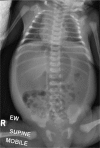Pullthrough Operation for Hirschsprung's Disease: Importance of a Circumferential (Donut) Biopsy at the Level of the Anastomosis
- PMID: 31312590
- PMCID: PMC6629996
- DOI: 10.1055/s-0039-1693494
Pullthrough Operation for Hirschsprung's Disease: Importance of a Circumferential (Donut) Biopsy at the Level of the Anastomosis
Abstract
Hirschsprung's disease is characterized by the absence of ganglia in the distal colon, resulting in a functional obstruction. It is managed by excision of the aganglionic segment and anastomosis of the ganglionated bowel just above the dentate line. The level of aganglionosis is determined by performing multiple seromuscular biopsies and/or full thickness biopsy on the antimesenteric border of the bowel to determine the level of pullthrough. The transition zone is described as being irregular, and hence a doughnut biopsy is recommended so that the complete circumference can be assessed. Herein, we described a child in whom there was a selective absence of ganglion cells in 30% of the circumference of the bowel along the mesenteric border for most of the transverse colon. This case defies the known concept of neural migration in an intramural and transmesenteric fashion and emphasizes the importance of a doughnut biopsy of the pulled-down segment.
Keywords: Hirschsprung's disease; atypical aganglionosis; skip lesions; zonal aganglionosis.
Conflict of interest statement
Figures



References
-
- Coventry S, Yost C, Palmiter R D, Kapur R P. Migration of ganglion cell precursors in the ileoceca of normal and lethal spotted embryos, a murine model for Hirschsprung disease. Lab Invest. 1994;71(01):82–93. - PubMed
-
- Ghosh D N, Liu Y, Cass D T, Soundappan S SV. Transition zone pull-through in Hirschsprung's disease: a tertiary hospital experience. ANZ J Surg. 2017;87(10):780–783. - PubMed
-
- O'Donnell A M, Puri P. Skip segment Hirschsprung's disease: a systematic review. Pediatr Surg Int. 2010;26(11):1065–1069. - PubMed
-
- Druckenbrod N R, Epstein M L. Age-dependent changes in the gut environment restrict the invasion of the hindgut by enteric neural progenitors. Development. 2009;136(18):3195–3203. - PubMed
Publication types
LinkOut - more resources
Full Text Sources

